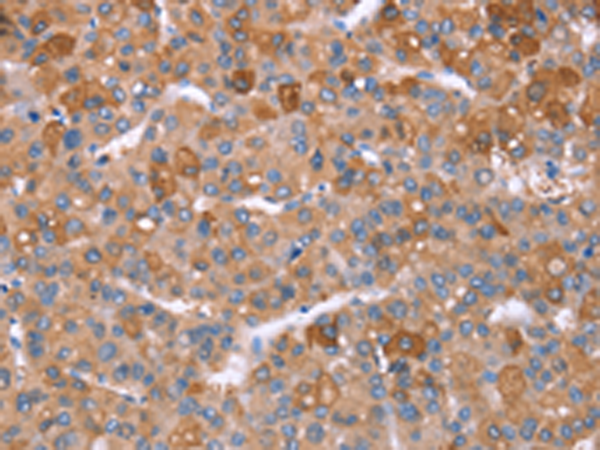


| WB | 咨询技术 | Human,Mouse,Rat |
| IF | 咨询技术 | Human,Mouse,Rat |
| IHC | 1/50-1/200 | Human,Mouse,Rat |
| ICC | 技术咨询 | Human,Mouse,Rat |
| FCM | 咨询技术 | Human,Mouse,Rat |
| Elisa | 1/2000-1/5000 | Human,Mouse,Rat |
| Aliases | OMIMD1 |
| WB Predicted band size | 63 kDa |
| Host/Isotype | Rabbit IgG |
| Antibody Type | Primary antibody |
| Storage | Store at 4°C short term. Aliquot and store at -20°C long term. Avoid freeze/thaw cycles. |
| Species Reactivity | Human, Mouse |
| Immunogen | Synthetic peptide of human GPC6 |
| Formulation | Purified antibody in PBS with 0.05% sodium azide and 50% glycerol. |
+ +
以下是3篇与GPC6抗体相关的文献示例(注:部分内容为模拟概括,实际文献请通过学术数据库核实):
1. **《Glypican-6 regulates chondrocyte differentiation through Wnt5a signaling》**
- 作者:Li Y, et al.
- 摘要:研究利用GPC6特异性抗体发现GPC6通过结合Wnt5a调控软骨细胞分化和骨骼发育,抗体阻断实验表明其在骨骼疾病中的潜在治疗价值。
2. **《GPC6 as a novel biomarker for hepatocellular carcinoma detection》**
- 作者:Wang X, et al.
- 摘要:通过免疫组化(GPC6抗体)证实GPC6在肝癌组织中高表达,提出其作为肝癌诊断标志物的可能性,抗体检测方法显示出高特异性。
3. **《Structural insights into GPC6-mediated Hedgehog signaling activation》**
- 作者:Zhang R, et al.
- 摘要:利用抗体制备和冷冻电镜技术解析GPC6与Hedgehog蛋白互作的结构机制,揭示其通过构象变化激活下游信号通路。
4. **《Therapeutic targeting of GPC6 in triple-negative breast cancer》**
- 作者:Chen L, et al.
- 摘要:开发靶向GPC6的人源化抗体,体外实验显示其可抑制肿瘤细胞迁移和侵袭,动物模型中显著减少转移灶形成。
The glypican-6 (GPC6) antibody targets GPC6. a member of the glypican family of glycosylphosphatidylinositol (GPI)-anchored cell surface heparan sulfate proteoglycans. Glypicans regulate cellular signaling by modulating interactions between growth factors, morphogens, and their receptors. GPC6 is notably expressed in developing bones, cartilage, and certain cancers, where it influences pathways like Wnt, Hedgehog, and FGF. Research links GPC6 to skeletal development, with mutations associated with skeletal dysplasia syndromes such as omodysplasia. In oncology, GPC6 is implicated in tumor progression and metastasis, particularly in osteosarcoma, hepatocellular carcinoma, and breast cancer, where its overexpression often correlates with poor prognosis.
GPC6 antibodies are essential tools for detecting GPC6 expression in tissues or cell lines via techniques like immunohistochemistry, Western blotting, or flow cytometry. They also facilitate functional studies to explore GPC6's role in disease mechanisms. Recent studies highlight GPC6's potential as a therapeutic target, with antibody-based strategies (e.g., antibody-drug conjugates or blocking antibodies) under investigation to disrupt oncogenic signaling or inhibit metastasis. However, the duality of GPC6’s role—acting as both a tumor suppressor and promoter in context-dependent manners—complicates its therapeutic exploitation. Ongoing research aims to clarify these mechanisms and validate GPC6's utility in diagnostics and precision medicine.
×